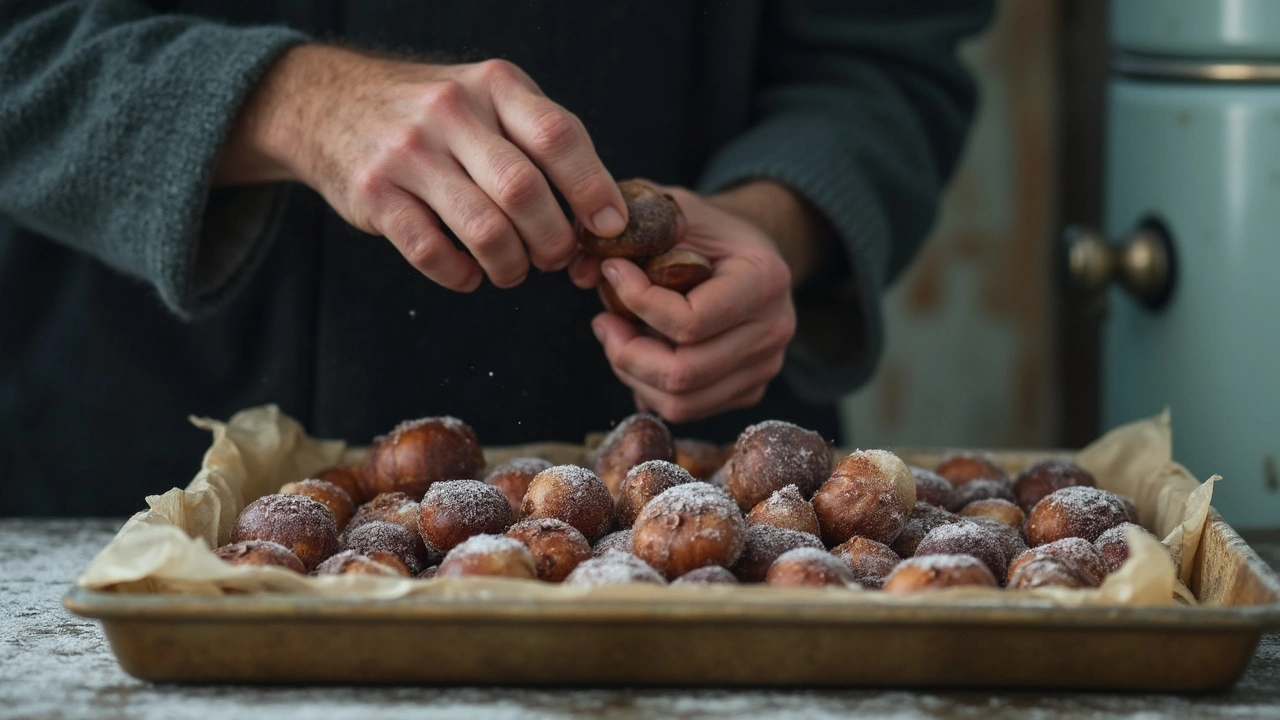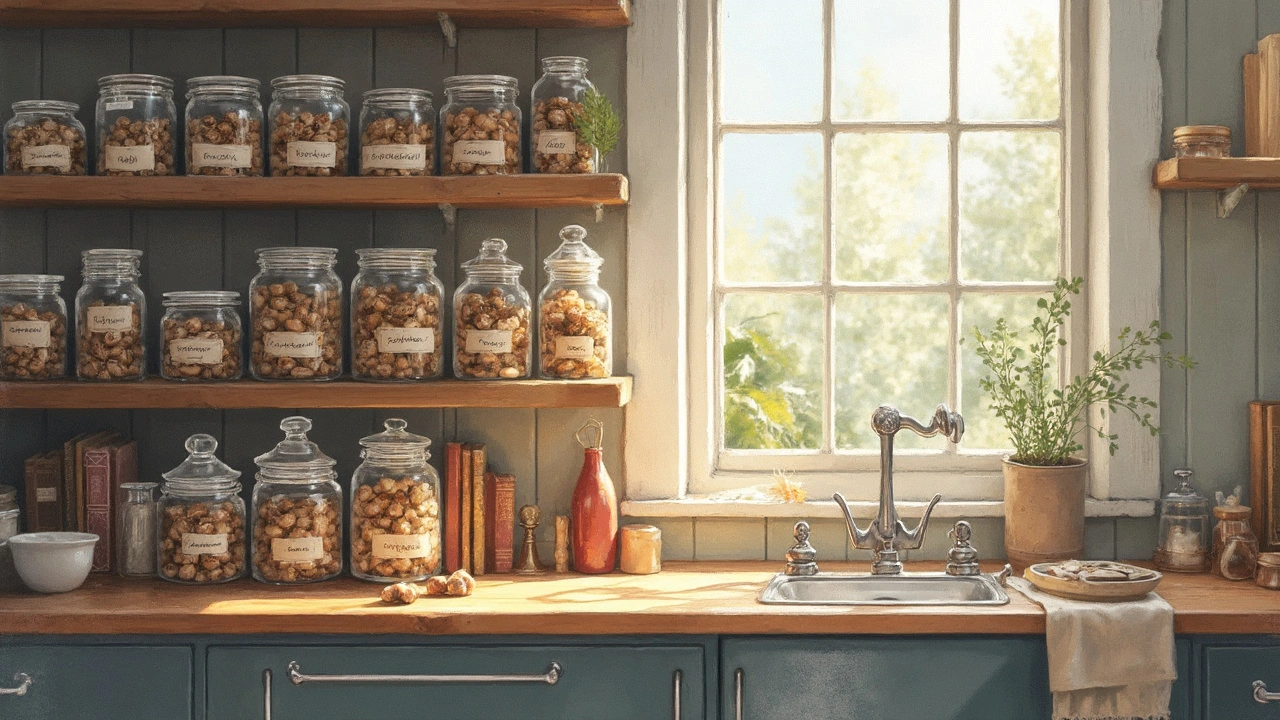Ever opened a bag of chestnuts to find a fuzzy, blue-green patch creeping across the shells? It stinks, literally. And what you can’t see—like invisible toxins from mold—matters just as much. Chestnuts are a treat, whether roasted over an oven flame, tossed into stuffing, or blitzed into purees. But they’re fussy, prone to mold and toxins if you don’t handle them right. I’ve personally watched perfectly good nuts ruined within days by a boneheaded storage mistake—yes, it was my fault—and you’re not alone if you’ve done the same. Chestnuts are different from most nuts: they’re high in water, low in fat, and way more like fruit than walnuts or hazelnuts. That’s why storage needs a little more thought, not just a toss in a bowl by the heater.
Why Chestnuts Spoil So Easily: The Fungus Among Us
Let’s straight talk: chestnuts are about 50% water when you pluck them from the shell. That means you’re basically holding a small fruit, not a crunchy, dry nut. And that moisture is a mold magnet, especially if air is humid or warm. Unlike almonds or pecans, chestnuts can actually rot from the inside out before you even see a trace of spoilage. That’s because microfungi love chestnut starches and sugars, and they squeeze right through shell cracks. If you’ve ever bitten into one only to taste a wine-like sourness or bitter off-flavors, you know what I mean. Every year, people end up chucking pounds of chestnuts because they underestimated how quickly mold can take over—and it takes just days if you leave them at room temperature. Moisture, heat, and oxygen form the unholy trinity for chestnut spoilage.
Mold on chestnuts—like the bluish-green Aspergillus—brings along a risk of mycotoxins. These invisible nasties can cause stomach issues and, in rare cases, worse. Europe ran a food safety study where they found that a surprising number of chestnuts on market shelves already showed low-level contamination after just one to two weeks. Makes you think twice about storing them in a fruit bowl, right? Back in Seattle, I found that even on a cool day, chestnuts left out for a few days develop tiny, sticky ‘sweat’ that’s a red flag. But you’re not powerless. If you use a solid system—like refrigeration, freezing, or drying—you keep the flavor, dodge the toxins, and enjoy chestnuts for months.
Refrigeration: The Fastest, Easiest Storage that Works
Okay, pop quiz: where do most folks get it wrong? Leaving chestnuts in a paper bag or trying a fancy wooden bowl on the countertop. This is basically inviting mold to a party. Refrigeration is the gold standard for fresh storage, especially if you’re planning to eat them within a couple of weeks. Here’s how you do it the smart way:
- Pick the right chestnuts: Start with the freshest nuts possible. Pass on anything with shell cracks, wrinkles, or that weird, hollow sound when you tap it. Plump is good, squishy is bad.
- Give them a bath: Wash your chestnuts in cool water. This washes off soil, spores, and any nasties from the shell. Some folks use a stiff brush, but I just agitate them around in the sink.
- Dry like you mean it: Let them air-dry afterwards. Water trapped in crevices is just asking for mold in the fridge. Don’t skip this step.
- Poke holes in a plastic bag: Chestnuts need to breathe, but not too much. Use a perforated plastic bag, or poke a dozen holes yourself. Unlike most produce, they need airflow to stop sweating.
- Cold and humid works best: Set your fridge to just above freezing—ideally 32°F to 35°F. If you have a produce drawer with humidity control, dial it up to high humidity.
- No apples or pears: Don’t store chestnuts near ethylene-producing fruits like apples or pears. Ethylene speeds up spoilage and weird flavors.
- Eat them within 2-3 weeks: Even in perfect conditions, chestnuts don’t last longer than this unless you freeze or dry them. Trust me, after week three, mold can sneak in.
Pro tip: Smell check your chestnuts every few days. If you get any hint of mustiness, toss the affected nuts or your whole batch could turn. I’ve dodged disaster more than once by catching a spoiled chestnut early. Also, the fridge method preserves natural sweetness. Some sources say you can scald chestnuts in boiling water for a minute, then chill them, which knocks back surface molds even further if you want bonus points.

Freezing Chestnuts: Locking in Freshness for Months
Want to save chestnuts beyond the season, maybe for a winter stew or next spring’s baking project? Freezing is the way to go, as it puts mold growth on ice (literally). And no, freezing won’t zap the natural flavor or ruin the texture if you prep right. Here’s the process, step by step:
- Choose your prep: You can freeze raw chestnuts in the shell, raw shelled chestnuts, or cooked chestnuts (roasted or boiled). My favorite? Cooked, because they’re ready to eat when thawed.
- Raw, in-shell freezing: Clean and dry the chestnuts. Slip them into a freezer bag, press out as much air as possible, and seal tight. Easy and effective for up to 6 months.
- Shelled chestnuts: Score the nuts around their middles, then blanch in boiling water for 2-3 minutes. Slip off the shells and pellicle (the bitter skin). Layer on a towel to dry. Spread in a single layer on a baking sheet in the freezer for an hour, then bag up. Spreading keeps them from sticking together.
- Cooked chestnuts: Roast or boil, then peel while warm. Once cool, freeze portions in airtight containers or bags. Add a label with the date so they don’t linger past their prime.
- Vacuum seal for the win: If you own a vacuum sealer, use it. Less air means less freezer burn and fewer odd flavors later.
- Thawing tips: Always thaw chestnuts in the fridge overnight, not on the counter. If you rush by microwaving, the texture can turn rubbery. Given their high water content, slow thawing preserves that creamy bite.
Here’s what makes freezing so clever: repeated tests show that frozen chestnuts retain their nutrients and taste way better than you’d guess. I often keep a stash to add to soups, desserts, or even stir-fries. And hey, if you want to geek out more about safe storage of chestnuts and health perks, there are loads of wild, lesser-known reasons to include them in your diet beyond just flavor. Being diligent here isn’t just about food waste, it’s about keeping chestnuts toxin-free and genuinely enjoyable.
Drying Chestnuts: The Old-School Way for Long-Term Storage
If you’re into chestnuts for the long haul, don’t sleep on drying. This method goes back centuries—people used to dry chestnuts on mesh racks above a hearth for weeks. Dried chestnuts lose their mold risk because, well, no water means nothing for fungi to feed on. The cool part? Dried chestnuts become portable snacks or the perfect add-in for winter soups and traditional recipes like Italian castagnaccio.
- Sun-drying (if you’ve got patience and a sunny spell): Split chestnuts in half (in the shell), lay them cut side up on wire mesh or baking racks in a sunny, breezy spot. Cover with mesh to keep bugs out. Move them indoors overnight. They’ll take about 10 days to dry, depending on humidity. Test by snapping one: it should break clean. This old-school route is slow, but no extra tools needed.
- Oven drying: Preheat your oven to the lowest setting—ideally 120°F to 140°F (most ovens only go down to 170°F, so crack the door with a wooden spoon to drop temp). Spread shelled chestnuts in a single layer on a baking tray lined with parchment. Let dry for 8-12 hours. Check and turn the nuts every few hours. When totally dry, chestnuts will be hard and rattle if shaken.
- Dehydrator drying: If you’ve got a dehydrator, set to 120°F. Lay out chestnuts in a single layer. Drying time ranges from 24 to 48 hours. Flip halfway. You’re aiming for nuts so hard you almost can’t bite them.
- Storage afterwards: Once dried, cool chestnuts to room temp. Store in airtight glass jars or sturdy freezer bags. Keep them in a cool, dry, dark place. I stashed a batch in my basement last year that tasted just as good six months down the line.
- Rehydrating later: Want to use them in a recipe? Soak dried chestnuts in warm water for a few hours or overnight. They’ll spring back to a tender texture, ready for soups, stuffing, or sweets.
- Bonus tip: Never dry chestnuts with even a hint of mold already visible. The process just locks in off flavors and toxins. Start with perfect specimens. Good drying not only prevents mold, but creates a supernut—nutrients and flavor are concentrated, and they’re easier to digest
Dried chestnuts are popular in Asian and Mediterranean kitchens. They’re used in everything from chestnut flour to desserts, and they’re my go-to for a protein-rich road trip snack. The key is patience—rushed drying equals chewy, not crunchy nuts.

Quick-Reference Tips: Keeping Chestnuts Safe, Tasty, and Mold-Free
If you’ve hung around chestnuts long enough (or if your fridge is as packed as mine), you’ll want some shortcuts and reminders. Here are a few real-world tricks I’ve picked up that you might not hear everywhere:
- Chestnuts are freshest right after harvest, and start to lose flavor as soon as they’re picked. Buy local, in-season, if possible. Imported ones tend to have sat around, even if they look fine.
- If you get a musty or alcoholic smell from a chestnut batch, skip tasting and toss them. Toxins aren’t always visible, but they give off warning smells.
- Don’t ever store chestnuts in a sealed, unventilated bag at room temperature. They’ll sweat, creating the perfect environment for bacteria and mold.
- Always check stored chestnuts before use. One bad nut can taint a whole batch.
- Chestnut shells are tough, but cracks or holes let in fungus. Handle gently, don’t drop or pile heavy items on them in the fridge or freezer.
- Use up any chestnuts showing signs of drying out (shriveling) quickly—they’re heading toward spoilage.
- Keep an eye on humidity. If your area or storage spot is very dry, nuts dry too quickly and get tough, but if too damp, they mold fast. Aim for a balanced, cool spot.
- For long-term storage, drying and freezing work best. The fridge is only a short-term solution.
Few foods strike such a balance between amazing flavor and careful handling as chestnuts do. Smart storage means you get to enjoy their sweet, nutty bite any time of year, worry-free. With a few routines, you’ll never see another moldy nut again. Give your chestnuts the care they deserve and enjoy the peace of mind—and taste—you get back.







Victoria Unikel
May 18, 2025 AT 22:44i was like “why do chestnuts get all funky?” then i learned they need cold love.
Lindsey Crowe
May 23, 2025 AT 19:03Wow, thanks for the PhD in chestnut storage, because we all totally forgot how to put food in a fridge.
Rama Hoetzlein
May 28, 2025 AT 15:21Chestnuts, in their humble husk, embody the paradox of nature: life cradled in moisture yet yearning for desiccation. The very water that grants them juiciness becomes the Achilles' heel, inviting fungal invaders that lurk like unseen marauders. One cannot simply dismiss this as a trivial kitchen quirk; it is a microcosm of ecological balance and human negligence. When we store them haphazardly, we are, in effect, inviting a silent toxin to germinate, a toxin that can ripple through our gut and mind. The Aspergillus spores, invisible to the naked eye, are no mere inconvenience; they are a real health hazard, as research has repeatedly shown. Thus, the act of refrigeration is not a luxury but a moral imperative, a small act of stewardship for the vulnerable seed. Freezing, on the other hand, transforms a perishable commodity into a time‑capsule, preserving not just flavor but cultural heritage. Drying, the ancient method, is a testament to human ingenuity in the face of climatic adversity. Each method, when executed correctly, becomes a bulwark against decay, a shield against the insidious spread of mold. Yet the true villain is complacency, the mindset that “it will be fine” until the faint sourness betrays its presence. Consider the economic cost of wasted chestnuts-thousands of dollars lost each year, not to mention the emotional toll of discarding a cherished harvest. Moreover, the environmental impact of food waste amplifies our collective responsibility. Therefore, the guidelines you presented are not mere suggestions but a roadmap to sustainable consumption. Adopt them, and you protect both your palate and public health. Ignore them, and you flirt with hazard in the most unassuming way. In conclusion, chestnut storage is a silent battle; equip yourself with refrigeration, freezing, or drying, and you emerge victorious. 💪
Lorena Garcia
June 2, 2025 AT 11:40Totally feel you on the whole “don’t be lazy” vibe, and honestly, I’ve started keeping a zip‑bag with holes in my fridge like you said-no more surprise mold parties.
Dietra Jones
June 7, 2025 AT 07:58Just a quick note: “chestnuts” should be plural without an apostrophe when you’re talking about many, not “chestnut’s”.
Victoria Guldenstern
June 12, 2025 AT 04:17In the grand theater of kitchen logistics, the chestnut emerges as a reluctant protagonist forced into a drama of moisture and decay without the fanfare of more glamorous nuts; the audience, however, remains blissfully unaware of the silent peril lurking beneath the shell, a peril that can only be mitigated through disciplined storage practices; the irony lies in the fact that such a humble seed, rich in cultural symbolism, requires the same level of care as a fine wine, yet many treat it with the indifference of a forgotten side dish; therefore, the recommendation to refrigerate, freeze, or dry is not merely culinary advice but a call to elevate our respect for this modest yet valuable fruit‑nut hybrid
Bill Bolmeier
June 17, 2025 AT 00:35Exactly! It’s like giving the chestnut a second chance at stardom-store it right and you’re the director of its delicious sequel.
Darius Reed
June 21, 2025 AT 20:54Imagine a world where chestnuts were left to their own devices: they'd form tiny fungal kingdoms, a nut‑based micro‑Utopia that nobody would want to eat-so let’s keep them out of that weird sci‑fi scenario.
Karen Richardson
June 26, 2025 AT 17:12“Plumb” should be “plump” when describing the ideal chestnut texture; also, “drier” is the correct comparative form for moisture content.
AnGeL Zamorano Orozco
July 1, 2025 AT 13:31Oh, the horror of a misspelled nut! If we can't even get “plump” right, how can we hope to master the alchemy of drying and freezing without turning our pantry into a battlefield of linguistic errors and moldy betrayals?
Cynthia Petersen
July 6, 2025 AT 09:49Sure, because everyone has a spare freezer just waiting to become a chestnut vault-right after you finish binge‑watching that show.
Marcia Hayes
July 11, 2025 AT 06:08Love the practical tips, gonna try the perforated bag tonight!
Danielle de Oliveira Rosa
July 16, 2025 AT 02:26From a philosophical standpoint, the chestnut teaches us patience; its slow maturation mirrors our own need to wait for the right conditions before we can truly flourish, much like the careful storage you described which honors the nut’s natural rhythm.
Tarun Rajput
July 20, 2025 AT 22:45It is incumbent upon the conscientious gastronome to recognize that the preservation of chestnuts is not merely an act of culinary convenience but an ethical obligation to mitigate food waste, to safeguard public health, and to honor the agrarian traditions from which these nuts descend; indeed, the methodological rigor you prescribe-refrigeration at precisely 32 °F to 35 °F, evacuation of atmospheric moisture via vacuum sealing, and the judicious application of dehydration protocols-constitutes a comprehensive framework that aligns with both modern food‑safety standards and historical practices; consequently, adherence to such protocols ensures that the organoleptic qualities of the chestnut are maintained whilst precluding the insidious proliferation of Aspergillus spp., thereby rendering the final product both palatable and safe for consumption; in sum, the integration of these storage strategies reflects a synthesis of scientific insight and cultural reverence.
Joe Evans
July 25, 2025 AT 19:03Wow!!! This is exactly the kind of thorough guide we need 😊👍; thank you for breaking it down so clearly!!!
Colin Boyd
July 30, 2025 AT 15:22While the guide is comprehensive one could argue that such meticulous care is overkill for a nut that many consume without incident.
John Petter
August 4, 2025 AT 11:40Clearly, the masses have never experienced true chestnut gastronomy.
Annie Tian
August 9, 2025 AT 07:59Indeed, embracing refined storage elevates even the simplest of foods!!!